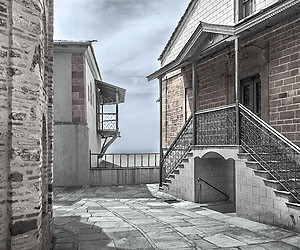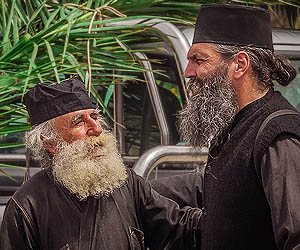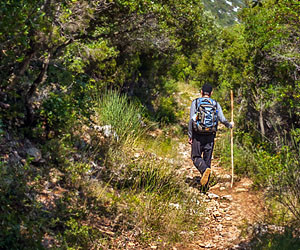Harmonious Blending of Nature and Building on Holy Mount Athos
1 September 2012Αs was brought out in the introduction, the environment of Mount Athos did not remain unaffected by human activities. These activities can be classified into three categories: a. construction needs (housing and shelter), b. agricultural needs and supplies and c. the use of the forest for timber and firewood.
a. Construction needs
The way in which sites were chosen for the building of the monasteries and other structures is worthy of notice. Almost all of the monasteries, as well as the skitae, houses, etc., have been built in such a way that they are found, except for a few examples, to be in absolute harmony with their surroundings. The materials used were stone, wood, clay tiles, and brick which blend in with the landscape and the natural environment. That means that in the years when no one talked about, or even thought about ecological consequences or conservation of the land, the monks instinctively showed environmental sensitivity. This sensitivity came from the canons of monastic life and their religious faith which required them to show respect to nature and to the aesthetics of the landscape. Ecologists could learn a lot from Mount Athos by noting the straightforward decisions which were made regarding land use and building materials, as well as the respect toward nature demonstrated by building their structures in such a way as to be in harmony with the landscape.
b. Agricultural areas
Agricultural areas in Mount Athos are and have always been for the purpose of meeting and supplementing the dietary needs of the monks, as their customs dictate. Agricultural products have rarely been used for income except for a few kellia and sketae that produced hazel nuts. The main agricultural crops of the past and present are:
Vegetable gardens which are usually found close to monasteries and cover the needs of the monks for fresh greens. They are set either on plots that surround the monasteries or houses, or on terraces which blend in well with nature and the monasteries themselves. Olive groves: The olive and olive oil constitute a basic element of the diet of the monks. For this reason, more space is given to olive production than to any other agricultural product. The cultivated olive groves, usually on small terraces, fit well in the area because of the fact that the wild olive is a member of the natural ecosystems.
Vineyards: Following the vegetable gardens and the olive groves, vineyards once constituted one of the most important agricultural activities. Not only is wine a necessary element of the liturgy, but it also accompanies the meals of the monks on days when they are not fasting. The existing vineyards fit in well with the natural environment.
Orchards: Hazelnuts were grown by some of the hermitages and houses in the past as an important means of income. There are no commercial orchards in Mount Athos today. Fruit trees such as apple, pear, cherry, peach, apricot and especially walnut are grown along the borders of the vegetable patches or on relatively small plots of land. Their products are welcome, seasonal contributions to the meals of the monks and the visitors. By their nature, orchard trees are not native to the environment but are usually found in the areas around the monasteries, hermitages and houses where the natural environment is somewhat damaged. They beautify the landscape with their flowers, foliage and fruits.
c. Felling operations – Forest management
The peninsula of Mount Athos has more forest coverage than any other region of Greece. The percentage of forested land is near 90% compared to the 40% in Halkidiki and 25% in the remainder of the country.
The relationship of the monks to the forests and forest products began in the age of the first settlements in Mount Athos. Wood was taken from the forest to construct the monasteries, houses and other buildings and also to keep them in repair. The monks needed poles for the vineyards and vegetable gardens, and they needed firewood for their energy needs. Because the method of cutting timber and transporting it were limited, the forest was used only to cover the needs of the monasteries, hermitages and houses, and it was confined to areas of the forest that were nearby. This is the reason for the somewhat poor appearance of the forests around almost all of the monasteries and also for the fact that the evergreen, broadleaved trees, especially, are degraded to a greater or lesser extent. The species which make up the forest ecosystems of Mount Athos have a great natural ability to regenerate quickly and profusely. The gaps and spaces that occurred each time trees were felled quickly grew up again and the ecosystem remained almost unchanged. Even after forest fires, this ecosystem is able to regenerate and readjust itself quite easily. A natural feature of the trees which are common to this area is the ability to sprout and regenerate quickly after fires. From the middle of the 19th century, a new era began for the relationship of the monks to the forest. Wood was not only used for the needs of the monasteries, but it began to be sold.
Source: «Το φυσικό κάλλος του Αγίου Όρους», “The natural beauty of Mount Athos”, Ημερολόγιο – Calendary 2003, Έκδοση «Αγιορείτικη Εστία» – Edition “Agioreitiki Estia”.












